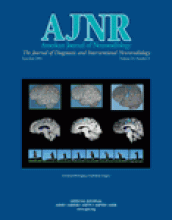Research ArticleBrain
Increased Signal Intensity in the Pulvinar on T1-Weighted Images: A Pathognomonic MR Imaging Sign of Fabry Disease
David F. Moore, Frank Ye, Raphael Schiffmann and John A. Butman
American Journal of Neuroradiology June 2003, 24 (6) 1096-1101;
David F. Moore
Frank Ye
Raphael Schiffmann

Submit a Response to This Article
Jump to comment:
No eLetters have been published for this article.
In this issue
Advertisement
David F. Moore, Frank Ye, Raphael Schiffmann, John A. Butman
Increased Signal Intensity in the Pulvinar on T1-Weighted Images: A Pathognomonic MR Imaging Sign of Fabry Disease
American Journal of Neuroradiology Jun 2003, 24 (6) 1096-1101;
Jump to section
Related Articles
- No related articles found.
Cited By...
- Increased resting cerebral blood flow in adult Fabry disease: MRI arterial spin labeling study
- Redefining the Pulvinar Sign in Fabry Disease
- Brain MR Imaging Findings of Cardiac-Type Fabry Disease with an IVS4+919G>A Mutation
- Hyperintense Dentate Nuclei on T1-Weighted MRI: Relation to Repeat Gadolinium Administration
- Brain Magnetic Resonance Imaging Findings Fail to Suspect Fabry Disease in Young Patients With an Acute Cerebrovascular Event
- Pulvinar: Associative role in cortical function and clinical correlations
- Cerebrovascular Involvement in Fabry Disease: Current Status of Knowledge
- Is CT Still Useful in the Study Protocol of Retinoblastoma?
- Invited Article: An MRI-based approach to the diagnosis of white matter disorders
- Diagnostic utility of different MRI and MR angiography measures in Fabry disease
- Central nervous system involvement in Anderson-Fabry disease: a clinical and MRI retrospective study
- Voxel based analyses of diffusion tensor imaging in Fabry disease
- Genomic abnormalities of the murine model of Fabry disease after disease-related perturbation, a systems biology approach
- Proteomics of specific treatment-related alterations in Fabry disease: A strategy to identify biological abnormalities
This article has not yet been cited by articles in journals that are participating in Crossref Cited-by Linking.
More in this TOC Section
Similar Articles
Advertisement











